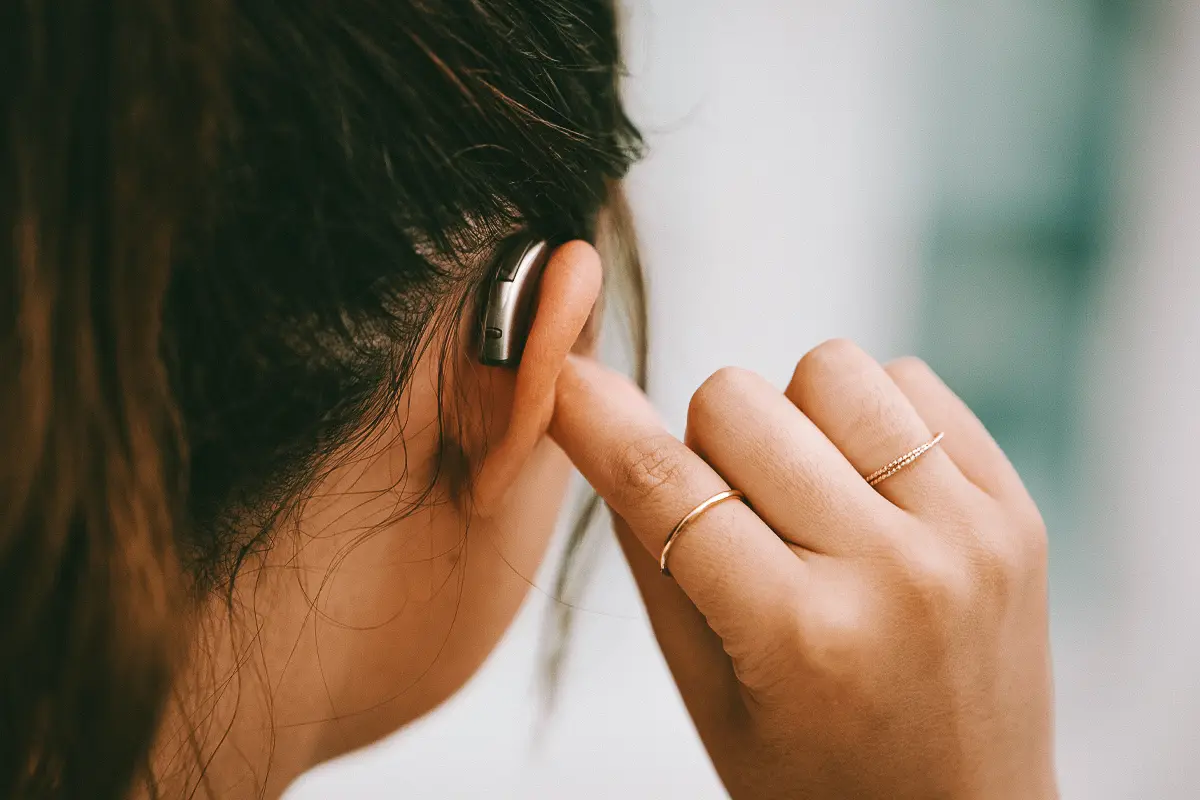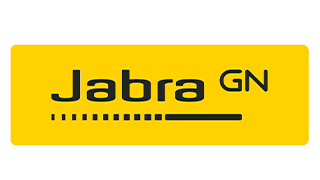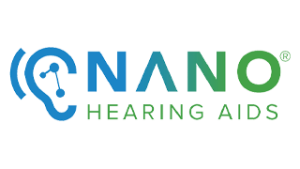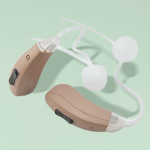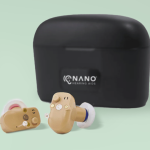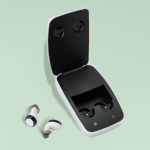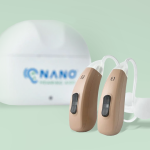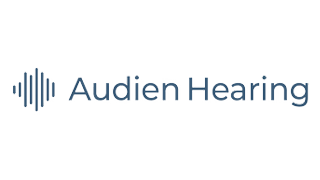Table of Contents
- We spent more than 7,500 hours researching dozens of hearing aids and using a 25-question checklist to identify standout contenders. Then, our team personally tested 27 of the most popular and highly rated devices.
- We’ve interviewed 26 real hearing aid users and consulted with 17 experts to learn which features are important when choosing a hearing aid.
- We conduct a thorough and hands-on testing process, evaluating setup and adjustment, comfort and fit, sound quality and performance, battery life and charging, ease of use, and support.
- Learn more about how we tested Nano hearing aids.
Key takeaways
- Nano is an online over-the-counter (OTC) hearing aid retailer that offers low-cost hearing aids for mild to moderate hearing loss.
- Nano hearing aids cost between $297–$697 per pair, depending on the model.
- We do not recommend Nano hearing aids because of lawsuits involving misleading marketing practices and multiple customer complaints.
We know that hearing loss can have a significant effect on mental health. Research shows that untreated hearing loss can lead to an increased risk of cognitive decline and depression, making reliable hearing aids an essential tool for both hearing health and overall well-being.
With over-the-counter (OTC) hearing aids now available, those with perceived mild to moderate hearing loss can purchase affordable devices without needing a prescription. Increased access and affordable pricing aside, OTC hearing aids do carry some risk. “My biggest concern with OTC hearing aids is the language being used of ‘perceived mild to moderate loss.’ Many people have a hard time identifying what level of hearing loss they actually have, so we are going to see a lot of people with severe hearing loss purchasing OTC devices,” says Rachael Cook, an audiologist with HearingUp. For this reason, she recommends everyone get a professional hearing test.
As the market becomes more saturated with budget-friendly hearing loss solutions, it’s important to research the brand and the product before buying—because not every brand upholds the same standards of quality and transparency. Some may not even be hearing aids at all.
For example, Nano Hearing Aids, a more affordable hearing brand, has received numerous complaints regarding misleading marketing practices and device performance issues. The state of Vermont sued Nano in January 2023. The lawsuit alleges that Nano engaged in multiple layers of deception by making misleading statements on its website and in advertisements, falsely representing them as U.S.-made, and implying its products were FDA-approved (when they weren’t). According to the lawsuit, Nano hearing devices are not hearing aids (since they’re not approved by the FDA), but personal sound amplification products (PSAPs). Hearing aids amplify select sounds for people with hearing loss while PSAPs amplify all sounds for activities like birdwatching or hunting.
Due to these concerns, we cannot confidently recommend Nano to our readers.
In this review, we will highlight current Nano models as well as several alternative OTC hearing aid brands that our testers have found to provide better value and trustworthiness, including Audien, MDHearing, and Jabra Enhance. These brands offer reliable technology to improve hearing and can help wearers stay socially connected and engaged in everyday life.
Note:
Nano recently launched a new line of hearing aids. While we haven’t yet tested them, they’re currently in our testing queue. We’ll update this article once we’ve completed testing.
Best alternative to Nano hearing aids: Jabra Enhance
We recommend Jabra Enhance because they offer high-quality OTC hearing aids with Bluetooth connectivity, advanced sound processing, and a 100-day risk-free trial. Additionally, Jabra Enhance’s comprehensive customer support has an excellent track record and consistently high ratings.
Nano Audacity RIC highlights
Our experience with Nano Audacity RIC
The Nano Audacity RIC introduces several advanced features not seen in the brand’s previous models. The inclusion of app control, Bluetooth streaming, and multi-mode directional microphones marks a technological step forward for the brand.
All Nano hearing aids come with rechargeable batteries and portable charging cases. The Audacity’s battery has a shorter life than many OTC competitors, offering up to 17 hours of use on a single charge without streaming. Those who use the streaming feature for most of the day may experience a significantly lower battery life. The website states that the portable charging case provides up to two full charges.
Nano’s reputation for unreliable performance and poor customer service remains a concern. While the Audacity RIC offers promising features on paper, past issues with Nano’s marketing practices and negative reviews of earlier models raise doubts about the product’s long-term reliability and performance. Given these concerns, we continue to advise caution and suggest exploring more trusted alternatives.
For more information, see our Bluetooth hearing aids review and our best hearing aids roundup.
Who may like it
- Tech-savvy people who want app control and Bluetooth streaming.
- Users looking for a discreet, receiver-in-canal design.
- Those who prefer rechargeable devices to avoid frequent battery changes.
Who may want to avoid it
- People needing longer Bluetooth streaming battery life.
- Those looking for extensive customer support.
Nano First Ear Pro BTE highlights
Our experience with Nano First Ear Pro BTE
The Nano First Ear Pro BTE offers a rechargeable battery, up to 20 hours of listening time per charge, and four customizable hearing programs. While it offers essential features like noise cancellation and easy sound adjustments, it lacks more advanced features like Bluetooth streaming with app integration and directional microphones, which are becoming standard in many modern OTC hearing aids.
Who may like it
- Those seeking affordable, rechargeable hearing aids.
- Users who want a behind-the-ear option.
- Those wanting simple, user-friendly controls.
Who may want to avoid it
- Users looking for Bluetooth streaming or app-controlled settings.
- Those wanting a more discreet, in-the-ear style.
Nano First Ear Pro CIC highlights
Our experience with First Ear Pro CIC
The Nano First Ear Pro CIC is an ultra-discreet, completely-in-canal (CIC) hearing aid designed for users seeking a nearly invisible, hassle-free option. With automatic on/off functionality and up to 18 hours of use per charge, this model offers convenience and ease of use. Wearers can toggle between four listening programs, making it suitable for different environments. The portable charging case provides three full recharges, which is handy for on-the-go users. However, the First Ear Pro CIC lacks advanced features such as Bluetooth streaming or app-based controls, which are available in similarly priced alternatives.
For more information about discreet hearing aids, see our best invisible hearing aids review.
Who may like it
- Users seeking a nearly invisible hearing aid.
- People who want simple controls and automatic on/off functionality.
Who may want to avoid it
- Users who need Bluetooth connectivity or app-based adjustments.
Nano First Ear Plus CIC highlights
Our experience with First Ear Plus CIC
The Nano First Ear Plus CIC is a budget-friendly, completely-in-canal hearing aid that offers simplicity. Its rechargeable design offers up to 18 hours of use on a single charge, and the auto on/off feature is designed to make it easy to operate right out of the charging case. The compact design should help the device remain virtually invisible when worn. While it offers basic noise control with two listening programs, the lack of advanced features like Bluetooth connectivity or app control limits its functionality.
Who may like it
- Users seeking an affordable, discreet hearing aid option.
- People looking for simple, easy-to-use controls with automatic functionality.
Who may want to avoid it
- Users who need more than two listening programs or advanced sound customization.
- Those looking for Bluetooth streaming or app-based adjustments.
Nano First Ear Plus ITE highlights
Our experience with First Ear Plus ITE
The Nano First Ear Plus ITE is designed for users who want a modern, earbud-style hearing aid that is both discreet and functional. With up to 38 hours of listening time per charge and a portable charging case that offers three full recharges, this device should be convenient for on-the-go users. It includes basic features such as feedback cancellation and noise management for improved sound quality, along with two listening programs to suit different environments. Like many of Nano’s products, the First Ear Plus ITE lacks Bluetooth connectivity and app control.
Who may like it
- Users seeking a modern, earbud-style hearing aid.
- People who prefer a long battery life and rechargeable option.
- Those who want simple controls without advanced customization.
Who may want to avoid it
- Users looking for more than two listening programs or Bluetooth streaming.
- Those who want a hearing aid with app-based controls and more sound adjustments.
Nano First Ear Plus BTE highlights
Our experience with First Ear Plus BTE
The Nano First Ear Plus BTE offers a budget-friendly option for users seeking a simple, rechargeable, behind-the-ear hearing aid. With up to 20 hours of battery life per charge and three full recharges available from the portable charging case, this model is likely to be convenient for daily wearers. It includes feedback cancellation and noise management features, designed to deliver clearer sound in various environments. However, it only provides two listening programs (its upgraded model, the First Ear Pro BTE offers four) and lacks more advanced features like Bluetooth or app-based controls. This model may appeal to those looking for an affordable, no-frills option.
Who may like it
- Users seeking an affordable, behind-the-ear hearing aid.
- Those who prefer simple, easy-to-use controls with rocker switches.
- People looking for rechargeable devices with moderate battery life.
Who may want to avoid it
- Users looking for Bluetooth streaming or app-based customization.
- Those who need more than two listening programs or advanced sound settings.
How much does Nano cost?
Nano’s six hearing aid models currently fall within the $297–$697 price range. While these prices might seem appealing compared with prescription hearing aids, other reliable OTC brands offer similar or better features at comparable costs. For instance, Audien hearing aids start at just $99, making them a more budget-friendly option, while MDHearing offers advanced models with app control and Bluetooth starting at around $397. To get the same features with Nano, you’d need to purchase its most advanced model for $697.
You can explore more in-depth comparisons and details about these alternatives in our Audien review, MDHearing review, and Jabra Enhance review.
Is Nano covered by insurance?
Insurance, Medicare, or Medicaid do not typically cover hearing aids. Medicare Part B may cover hearing tests but does not cover hearing aids themselves. Medicare Advantage (Part C) plans may offer some hearing aid coverage depending on the specific plan, so it’s worth checking with your provider. Similarly, Medicaid coverage for hearing aids varies by state, but generally, OTC models like Nano are not included.
How to save money on Nano hearing aids
While Nano hearing aids are already positioned as a more affordable OTC option, the company does not appear to offer direct assistance programs like some competitors. Nano provides installment payment plans through third-party financing services like Affirm, allowing users to spread out payments over time. The brand frequently offers promotional discounts on their website, and purchasing during sales may help lower costs. It’s also worth comparing Nano’s prices with competitors offering similar financing options, such as Jabra Enhance or MDHearing. You can also explore all of our budget-friendly recommendations in our affordable hearing aids review.
Nano hearing aid customizations and features
All Nano hearing aids come with multiple preprogrammed listening programs, offering between two and four programs, depending on the model. These programs allow users to tailor their hearing aids to different environments, such as restaurants, outdoor settings, or listening to music. The Audacity RIC model offers smartphone app control for selecting and adjusting these programs. Users select and adjust programs using the on-device buttons for other models like the First Ear Pro and First Ear Plus series.
Other features Nano hearing aids include:
- Rechargeable batteries with portable charging cases.
- Noise management and feedback cancellation.
- Auto on/off functionality with the charging case for easy use.
- Simple on-device controls (rocker switch or push button) for volume and program selection.
- 45-day money-back guarantee.
- One-year warranty.
Our testing experience
With FDA approval, the OTC hearing aid market experienced rapid growth with an influx of new companies. While this improves accessibility and helps drive down prices, it also muddies the waters. How do you know which products are trustworthy?
When choosing hearing aids to test, we survey the market, interview hearing health experts, and speak to real hearing aid users. To date, we’ve curated a list of 21 OTC models to test from nine brands: Audien, Audicus, Eargo, Go Hearing, Jabra Enhance, Lexie, Lucid, MDHearing, and Sony. We chose these brands because they have positive reputations and represent a range of prices, styles, and features.
We also tested prescription models from Oticon, Phonak, and Starkey to experience the difference between OTC and Rx (prescription) hearing aids firsthand.
The process looked like this:
Our testers try multiple devices and answer 25 questions about each. We use these answers to look for outstanding performers. For example, the clarity of the Jabra Enhance Select 200 immediately catches our testers’ attention like no other OTC hearing aid.
From our tester
“Jabra Enhance Select 200 has great sound quality for different environments. I can really tell the difference between the listening programs.”
We also look for hearing aids that demonstrate consistent quality in fundamental features, like sound clarity, setup, comfort, and ease of use. Brands that don’t meet those standards didn’t make it onto our best-of list.
No brand’s hearing aids perform flawlessly. For example, one of our testers runs into trouble right away with the MDHearing Volt: the Quick Start Guide doesn’t explain how to turn it on.
We also complete onboarding calls with brand audiologists and talk with customer service representatives over the phone and through chat modules to accurately replicate the buying process and evaluate post-purchase support options.
Finally, we continue our testing by interviewing independent audiologists, hearing instrument specialists, mental health experts, and hearing aid users to get additional perspectives on OTC hearing aids.
The case for OTC hearing aids is particularly compelling. Being able to reach a wider population by increasing accessibility, simplifying the ease of fitting, and reducing the cost barriers … opens the gateway to an array of possibilities [previously inaccessible] due to exorbitant costs and lack of insurance coverage.
Shelley Singh, AuD
For more information, see how we test hearing aids.
Compare Nano hearing aid models
| Cost | $697 | $497 | $397 | $297 | $347 | $297 |
| Style | RIC | BTE | CIC | CIC | ITE | BTE |
| Hearing modes | 3 | 4 | 4 | 2 | 2 | 2 |
| Maximum rechargeable battery life (hours) | 17 | 20 | 18 | 18 | 38 | 20 |
| Microphones | Directional | Omnidirectional | Omnidirectional | Omnidirectional | Omnidirectional | Omnidirectional |
| Bluetooth streaming and app? | Yes | No | No | No | No | No |
Alternatives to Nano
Jabra Enhance
Jabra Enhance is our top recommendation for those seeking high-quality OTC hearing aids. Known for offering advanced features like Bluetooth streaming, app control, and great sound processing, Jabra Enhance stands out as a premium OTC option. The brand offers a range of models with personalized sound adjustments, allowing users to fine-tune their hearing experience via a smartphone app (Nano doesn’t offer this). Additionally, Jabra provides helpful support with access to audiologists and a generous 100-day risk-free trial. While Jabra Enhance is priced higher than Nano, starting at $995, the technology and customer service make it a much more reliable choice for those who want both performance and peace of mind.
MDHearing
MDHearing is a solid mid-tier alternative that balances affordability and key features. The brand offers four models with basic functionality, but Bluetooth connectivity or app control is only available with the Volt Max. MDHearing devices are designed for users with mild to moderate hearing loss, similar to Nano, but with the benefit of FDA-cleared self-fitting technology. The brand’s pricing starts at $297, making it the same price but a better-supported option than Nano.
Audien
Audien offers the most budget-friendly alternative to Nano, with prices starting as low as $99. Though lacking some of the advanced features found in Jabra, Audien hearing aids are simple, affordable, and effective for individuals with mild to moderate hearing loss. The brand’s entry-level devices are designed for users looking for a low-cost, no-frills option. Audien hearing aids do not include Bluetooth streaming or app control, but they provide essential sound amplification in a discreet design. With a focus on simplicity and affordability, Audien is a great option for budget-conscious users who need basic hearing support.
Nano alternative comparison
| Cost | $297–$697 | $995–$1,995 | $297–$397 | $99–$689 |
| Styles available | CIC, ITE, RIC, BTE | CIC, ITC, ITE, RIC, BTE | CIC, ITC, BTE | ITE, BTE |
| Bluetooth/app | Yes, one model | Yes | No | Yes, one model |
| Trial period | 45 days | 100 days | 45 days | 45 days |
| Warranty | 1 year | 1 or 3 years, depending on package | 1 year | Protection plan available for additional fee |
Our final verdict on the Nano hearing aids
While Nano hearing aids may seem appealing due to their low price and basic features, the brand’s history of unreliable performance, poor customer service, and questionable marketing practices make it hard to recommend. The Audacity RIC offers modern features such as Bluetooth connectivity, but the remainder of the Nano lineup only offers basic functionality you can easily find in other models with a better reputation. Alternatives like Jabra Enhance, MDHearing, and Audien offer better overall value and warranties, great customer support, and proven performance track records. While our team plans on testing Nano’s new products, we recommend exploring more reliable options that offer greater peace of mind and better long-term satisfaction.
Frequently asked questions
Nano Hearing Aids is a company based in the United States. However, the brand’s products are produced overseas, and the brand has faced criticism for misleading marketing practices and poor product reliability.
Currently, Nano’s only model with Bluetooth connectivity is the Audacity RIC. This model can connect to a compatible app, allowing users to adjust settings, volume, and listening programs. It also allows for audio streaming and hands-free calls.
The top-rated OTC hearing aid often depends on individual needs and who you ask. Jabra Enhance consistently receives high ratings for its advanced features, including Bluetooth streaming, personalized app controls, and strong customer support. It is our highest-scoring hearing aid after testing, with a 9.9 out of 10 rating. It offers a blend of high-tech functionality and reliability, making it a standout choice in the OTC hearing aid market. However, there are many quality OTC hearing aids, and more brands have appeared in the market that are worth consideration.
- Johns Hopkins study links hearing loss with dementia in older adults. Johns Hopkins University. 2023, January 11). Link
- Effects of untreated hearing loss. Audiology and Hearing Aid Services, LLC. (2024, January 23). Link
- U.S. Department of Health and Human Services. (n.d.). Over-the-counter hearing aids. National Institute of Deafness and Other Communication Disorders. Link
- Attorney general sues over-the-counter hearing aid company Nano for misleading consumers. (2023, January 3) Office of the Vermont Attorney General. Jan. 3, 2023. Link
- Yadav, A. K., Ahsan, A., & Kumar, V. (2023). Impact of hearing aid usage on emotional and social skills in persons with severe to profound hearing loss. Journal of Audiology & Otology, 27(1), 10–15. Link
- Research and Markets. (2023). Over-the-counter (OTC) hearing aids market size, market share, application analysis, regional outlook, growth trends, key players, competitive strategies and forecasts-2023 to 2031. Link



